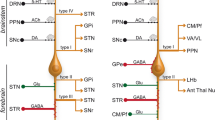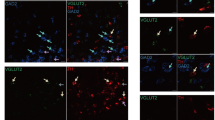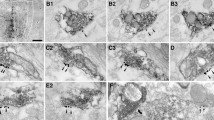Abstract
The ventral pallidum (VP) is a part of the ventral striatopallidal system and is involved in reward-related behaviors. The VP is composed of a ventromedial (VPvm) and a dorsolateral (VPdl) subregion, and some rostral-caudal differences are reported. Study of the VP often focuses on the subcommissural VP, typically considered homogenous in spite of known subdivisions. In this work, we used slice electrophysiology combined with immunohistochemistry for marker neuropeptides to test whether the subcommissural VP is functionally homogenous. Using sagittal slices, we show that more lateral levels (2.40 mm) of the subcommissural VP are homogenous but that a more medial slice (1.90 mm) contains two types of neurons. One type, located more caudally, resembles neurons in the lateral subcommissural VP, with long aspiny dendrites, primarily GABAergic input, and characteristic electrophysiological properties, such as depolarized membrane potential and spontaneous action potential discharge. The second type of neuron, located mostly in the rostral subcommissural VP, shows properties that are akin to medium spiny neurons of adjacent regions, including spiny dendrites, major glutamatergic input, hyperpolarized membrane potential, and no spontaneous action potentials. The two types of neurons were present in both the VPvm and VPdl, implying that the mix is not a characteristic of histologically defined subregions. We conclude that at medial levels the rostral subcommissural VP contains a mix of typical ventral pallidal neurons and spiny neurons similar to those in adjacent regions. This observation needs to be considered when interpreting past experiments and designing future experiments in the subcommissural VP.






Similar content being viewed by others
References
Alheid GF (2003) Extended amygdala and basal forebrain. Ann N Y Acad Sci 985:185–205
Alheid GF, Heimer L (1988) New perspectives in basal forebrain organization of special relevance for neuropsychiatric disorders: the striatopallidal, amygdaloid, and corticopetal components of substantia innominata. Neuroscience 27(1):1–39
Bell K, Churchill L, Kalivas PW (1995) GABAergic projection from the ventral pallidum and globus pallidus to the subthalamic nucleus. Synapse 20(1):10–18. doi:10.1002/syn.890200103
Bengtson CP, Osborne PB (1999) Electrophysiological properties of anatomically identified ventral pallidal neurons in rat brain slices. Ann N Y Acad Sci 877:691–694
Bengtson CP, Osborne PB (2000) Electrophysiological properties of cholinergic and noncholinergic neurons in the ventral pallidal region of the nucleus basalis in rat brain slices. J Neurophysiol 83(5):2649–2660
Bengtson CP, Lee DJ, Osborne PB (2004) Opposing electrophysiological actions of 5-HT on noncholinergic and cholinergic neurons in the rat ventral pallidum in vitro. J Neurophysiol 92(1):433–443. doi:10.1152/jn.00543.2003
Churchill L, Kalivas PW (1994) A topographically organized gamma-aminobutyric acid projection from the ventral pallidum to the nucleus accumbens in the rat. J Comp Neurol 345(4):579–595. doi:10.1002/cne.903450408
Cromwell HC, Berridge KC (1993) Where does damage lead to enhanced food aversion: the ventral pallidum/substantia innominata or lateral hypothalamus? Brain Res 624(1–2):1–10
Fabbricatore AT, Ghitza UE, Prokopenko VF, West MO (2010) Electrophysiological evidence of mediolateral functional dichotomy in the rat nucleus accumbens during cocaine self-administration II: phasic firing patterns. Eur J Neurosci 31(9):1671–1682. doi:10.1111/j.1460-9568.2010.07230.x
Forcelli PA, West EA, Murnen AT, Malkova L (2012) Ventral pallidum mediates amygdala-evoked deficits in prepulse inhibition. Behav Neurosci 126(2):290–300. doi:10.1037/a0026898
Fuller TA, Russchen FT, Price JL (1987) Sources of presumptive glutamergic/aspartergic afferents to the rat ventral striatopallidal region. J Comp Neurol 258(3):317–338. doi:10.1002/cne.902580302
Gartner U, Hartig W, Riedel A, Brauer K, Arendt T (2002) Immunocytochemical evidence for the striatal nature of the rat lateral part of interstitial nucleus of the posterior limb of the anterior commissure (IPAC). J Chem Neuroanat 24(2):117–125
Gritti I, Mainville L, Jones BE (1993) Codistribution of GABA—with acetylcholine-synthesizing neurons in the basal forebrain of the rat. J Comp Neurol 329(4):438–457. doi:10.1002/cne.903290403
Groenewegen HJ, Berendse HW, Wolters JG, Lohman AH (1990) The anatomical relationship of the prefrontal cortex with the striatopallidal system, the thalamus and the amygdala: evidence for a parallel organization. Prog Brain Res 85:95–116 (discussion 116–118)
Groenewegen HJ, Berendse HW, Haber SN (1993) Organization of the output of the ventral striatopallidal system in the rat: ventral pallidal efferents. Neuroscience 57(1):113–142
Haber SN, Nauta WJ (1983) Ramifications of the globus pallidus in the rat as indicated by patterns of immunohistochemistry. Neuroscience 9(2):245–260
Hanlon EC, Baldo BA, Sadeghian K, Kelley AE (2004) Increases in food intake or food-seeking behavior induced by GABAergic, opioid, or dopaminergic stimulation of the nucleus accumbens: is it hunger? Psychopharmacology 172(3):241–247. doi:10.1007/s00213-003-1654-0
Heimer L, Wilson RD (1975) The subcortical projections of the allocortex: similarities in the neural associations of the hippocampus, the piriform cortex, and the neocortex. In: Santini M (ed) Golgi centennial symposium proceedings. Raven Press, New York, pp 177–193
Heimer L, Zahm DS, Churchill L, Kalivas PW, Wohltmann C (1991) Specificity in the projection patterns of accumbal core and shell in the rat. Neuroscience 41(1):89–125
Heimer L, Alheid GF, de Olmos JS, Groenewegen HJ, Haber SN, Harlan RE, Zahm DS (1997a) The accumbens: beyond the core-shell dichotomy. J Neuropsychiatry Clin Neurosci 9(3):354–381
Heimer L, Harlan RE, Alheid GF, Garcia MM, de Olmos J (1997b) Substantia innominata: a notion which impedes clinical-anatomical correlations in neuropsychiatric disorders. Neuroscience 76(4):957–1006
Hiroi N, White NM (1993) The ventral pallidum area is involved in the acquisition but not expression of the amphetamine conditioned place preference. Neurosci Lett 156(1–2):9–12
Holt AG (1030) Newman SW (2004) Distribution of methionine and leucine enkephalin neurons within the social behavior circuitry of the male Syrian hamster brain. Brain Res 1:28–48. doi:10.1016/j.brainres.2004.09.034
Hubner CB, Koob GF (1990) The ventral pallidum plays a role in mediating cocaine and heroin self-administration in the rat. Brain Res 508(1):20–29
Johnson PI, Napier TC (1996) Contribution of the nucleus accumbens to cocaine-induced responses of ventral pallidal neurons. Synapse 22(3):253–260. doi:10.1002/(SICI)1098-2396(199603)22:3<253:AID-SYN8>3.0.CO;2-B
Kalivas PW, Jackson D, Romanidies A, Wyndham L, Duffy P (2001) Involvement of pallidothalamic circuitry in working memory. Neuroscience 104(1):129–136
Kelley AE, Domesick VB, Nauta WJ (1982) The amygdalostriatal projection in the rat—an anatomical study by anterograde and retrograde tracing methods. Neuroscience 7(3):615–630
Kodsi MH, Swerdlow NR (1997) Regulation of prepulse inhibition by ventral pallidal projections. Brain Res Bull 43(2):219–228
Koester J, Siegelbaum SA (2000) Local signaling: passive electrical properties of the neuron. In: Kandel ER, Schwartz JH, Jessell TM (eds) Principles of neural science, 4th edn. McGraw-Hill, New York
Lavin A, Grace AA (1996) Physiological properties of rat ventral pallidal neurons recorded intracellularly in vivo. J Neurophysiol 75(4):1432–1443
Maidment NT, Brumbaugh DR, Rudolph VD, Erdelyi E, Evans CJ (1989) Microdialysis of extracellular endogenous opioid peptides from rat brain in vivo. Neuroscience 33(3):549–557
Martin TJ, Coller M, Co C, Smith JE (2008) Mu-opioid receptor alkylation in the ventral pallidum and ventral tegmental area, but not in the nucleus accumbens, attenuates the effects of heroin on cocaine self-administration in rats. Neuropsychopharmacology 33(5):1171–1178. doi:10.1038/sj.npp.1301490
Maurice N, Deniau JM, Menetrey A, Glowinski J, Thierry AM (1997) Position of the ventral pallidum in the rat prefrontal cortex-basal ganglia circuit. Neuroscience 80(2):523–534
McFarland K, Kalivas PW (2001) The circuitry mediating cocaine-induced reinstatement of drug-seeking behavior. J Neurosci 21(21):8655–8663
Mitrovic I, Napier TC (1995) Electrophysiological demonstration of mu, delta and kappa opioid receptors in the ventral pallidum. J Pharmacol Exp Ther 272(3):1260–1270
Mogenson GJ, Yang CR (1991) The contribution of basal forebrain to limbic-motor integration and the mediation of motivation to action. Adv Exp Med Biol 295:267–290
Mogenson GJ, Jones DL, Yim CY (1980) From motivation to action: functional interface between the limbic system and the motor system. Prog Neurobiol 14(2–3):69–97
Nambu A, Llinas R (1997) Morphology of globus pallidus neurons: its correlation with electrophysiology in guinea pig brain slices. J Comp Neurol 377(1):85–94
Napier TC (1993) Transmitter actions and interactions on pallidal neuronal function. In: Kalivas PW, Barnes CD (eds) Limbic motor circuits and neuropsychiatry. CRC Press, Boca Raton, pp 125–153
Napier TC, Mitrovic I (1999) Opioid modulation of ventral pallidal inputs. Ann N Y Acad Sci 877:176–201
O’Donnell P, Grace AA (1993) Physiological and morphological properties of accumbens core and shell neurons recorded in vitro. Synapse 13(2):135–160. doi:10.1002/syn.890130206
Olive MF, Anton B, Micevych P, Evans CJ, Maidment NT (1997) Presynaptic versus postsynaptic localization of mu and delta opioid receptors in dorsal and ventral striatopallidal pathways. J Neurosci 17(19):7471–7479
Panagis G, Miliaressis E, Anagnostakis Y, Spyraki C (1995) Ventral pallidum self-stimulation: a moveable electrode mapping study. Behav Brain Res 68(2):165–172
Pang K, Tepper JM, Zaborszky L (1998) Morphological and electrophysiological characteristics of noncholinergic basal forebrain neurons. J Comp Neurol 394(2):186–204
Paxinos G, Watson C (2006) The Rat Brain in Stereotaxic Coordinates, 6th edn. Academic Press, San Diego
Pecina S, Berridge KC (2005) Hedonic hot spot in nucleus accumbens shell: where do mu-opioids cause increased hedonic impact of sweetness? J Neurosci 25(50):11777–11786. doi:10.1523/JNEUROSCI.2329-05.2005
Pickel VM, Shobin ET, Lane DA, Mackie K (2012) Cannabinoid-1 receptors in the mouse ventral pallidum are targeted to axonal profiles expressing functionally opposed opioid peptides and contacting N-acylphosphatidylethanolamine-hydrolyzing phospholipase D terminals. Neuroscience 227C:10–21. doi:10.1016/j.neuroscience.2012.07.050
Robledo P, Koob GF (1993) Two discrete nucleus accumbens projection areas differentially mediate cocaine self-administration in the rat. Behav Brain Res 55(2):159–166
Root DH, Fabbricatore AT, Ma S, Barker DJ, West MO (2010) Rapid phasic activity of ventral pallidal neurons during cocaine self-administration. Synapse 64(9):704–713. doi:10.1002/syn.20792
Root DH, Fabbricatore AT, Pawlak AP, Barker DJ, Ma S, West MO (2012a) Slow phasic and tonic activity of ventral pallidal neurons during cocaine self-administration. Synapse 66(2):106–127. doi:10.1002/syn.20990
Root DH, Ma S, Barker DJ, Megehee L, Striano BM, Ralston CM, Fabbricatore AT, West MO (2012b) Differential roles of ventral pallidum subregions during cocaine self-administration behaviors. J Comp Neurol. doi:10.1002/cne.23191
Shammah-Lagnado SJ, Alheid GF, Heimer L (1999) Afferent connections of the interstitial nucleus of the posterior limb of the anterior commissure and adjacent amygdalostriatal transition area in the rat. Neuroscience 94(4):1097–1123
Shammah-Lagnado SJ, Alheid GF, Heimer L (2001) Striatal and central extended amygdala parts of the interstitial nucleus of the posterior limb of the anterior commissure: evidence from tract-tracing techniques in the rat. J Comp Neurol 439(1):104–126. doi:10.1002/cne.1999
Skoubis PD, Maidment NT (2003) Blockade of ventral pallidal opioid receptors induces a conditioned place aversion and attenuates acquisition of cocaine place preference in the rat. Neuroscience 119(1):241–249
Smith KS, Berridge KC (2005) The ventral pallidum and hedonic reward: neurochemical maps of sucrose “liking” and food intake. J Neurosci 25(38):8637–8649. doi:10.1523/JNEUROSCI.1902-05.2005
Smith KS, Tindell AJ, Aldridge JW, Berridge KC (2009) Ventral pallidum roles in reward and motivation. Behav Brain Res 196(2):155–167. doi:10.1016/j.bbr.2008.09.038
Switzer RC 3rd, Hill J, Heimer L (1982) The globus pallidus and its rostroventral extension into the olfactory tubercle of the rat: a cyto- and chemoarchitectural study. Neuroscience 7(8):1891–1904
Taha SA, Katsuura Y, Noorvash D, Seroussi A, Fields HL (2009) Convergent, not serial, striatal and pallidal circuits regulate opioid-induced food intake. Neuroscience 161(3):718–733. doi:10.1016/j.neuroscience.2009.03.057
Tang XC, McFarland K, Cagle S, Kalivas PW (2005) Cocaine-induced reinstatement requires endogenous stimulation of mu-opioid receptors in the ventral pallidum. J Neurosci 25(18):4512–4520. doi:10.1523/JNEUROSCI.0685-05.2005
Tindell AJ, Smith KS, Pecina S, Berridge KC, Aldridge JW (2006) Ventral pallidum firing codes hedonic reward: when a bad taste turns good. J Neurophysiol 96(5):2399–2409. doi:10.1152/jn.00576.2006
Tripathi A, Prensa L, Cebrian C, Mengual E (2010) Axonal branching patterns of nucleus accumbens neurons in the rat. J Comp Neurol 518(22):4649–4673. doi:10.1002/cne.22484
Wilson FA, Rolls ET (1990) Neuronal responses related to reinforcement in the primate basal forebrain. Brain Res 509(2):213–231
Yin HH, Knowlton BJ (2006) The role of the basal ganglia in habit formation. Nat Rev Neurosci 7(6):464–476. doi:10.1038/nrn1919
Zahm DS (1989) The ventral striatopallidal parts of the basal ganglia in the rat-II. Compartmentation of ventral pallidal efferents. Neuroscience 30(1):33–50
Zahm DS (1998) Is the caudomedial shell of the nucleus accumbens part of the extended amygdala? A consideration of connections. Crit Rev Neurobiol 12(3):245–265
Zahm DS, Heimer L (1988) Ventral striatopallidal parts of the basal ganglia in the rat: I. Neurochemical compartmentation as reflected by the distributions of neurotensin and substance P immunoreactivity. J Comp Neurol 272(4):516–535. doi:10.1002/cne.902720406
Zahm DS, Heimer L (1990) Two transpallidal pathways originating in the rat nucleus accumbens. J Comp Neurol 302(3):437–446. doi:10.1002/cne.903020302
Zahm DS, Zaborszky L, Alones VE, Heimer L (1985) Evidence for the coexistence of glutamate decarboxylase and Met-enkephalin immunoreactivities in axon terminals of rat ventral pallidum. Brain Res 325(1–2):317–321
Zahm DS, Williams E, Wohltmann C (1996) Ventral striatopallidothalamic projection: IV. Relative involvements of neurochemically distinct subterritories in the ventral pallidum and adjacent parts of the rostroventral forebrain. J Comp Neurol 364 (2):340-362. doi:10.1002/(SICI)1096-9861(19960108)364:2<340::AID-CNE11>3.0.CO;2-T
Zahm DS, Parsley KP, Schwartz ZM, Cheng AY (2012) On lateral septum-like characteristics of outputs from the accumbal hedonic ‘hotspot’ of Pecina and Berridge with commentary on the transitional nature of basal forebrain ‘boundaries’. J Comp Neurol. doi:10.1002/cne.23157
Zarrindast MR, Ebrahimi-Ghiri M, Rostami P, Rezayof A (2007) Repeated pre-exposure to morphine into the ventral pallidum enhances morphine-induced place preference: involvement of dopaminergic and opioidergic mechanisms. Behav Brain Res 181(1):35–41. doi:10.1016/j.bbr.2007.03.019
Zhang M, Kelley AE (1997) Opiate agonists microinjected into the nucleus accumbens enhance sucrose drinking in rats. Psychopharmacology 132(4):350–360
Zhang M, Kelley AE (2000) Enhanced intake of high-fat food following striatal mu-opioid stimulation: microinjection mapping and fos expression. Neuroscience 99(2):267–277
Acknowledgments
We would like to thank Rachel Smith for assistance with enkephalin immunostaining. This work was supported by USPHA grants DA015369, DA012513, DA003906, and by the Neuroscience Institute, Medical University of South Carolina.
Author information
Authors and Affiliations
Corresponding author
Rights and permissions
About this article
Cite this article
Kupchik, Y.M., Kalivas, P.W. The rostral subcommissural ventral pallidum is a mix of ventral pallidal neurons and neurons from adjacent areas: an electrophysiological study. Brain Struct Funct 218, 1487–1500 (2013). https://doi.org/10.1007/s00429-012-0471-9
Received:
Accepted:
Published:
Issue Date:
DOI: https://doi.org/10.1007/s00429-012-0471-9




